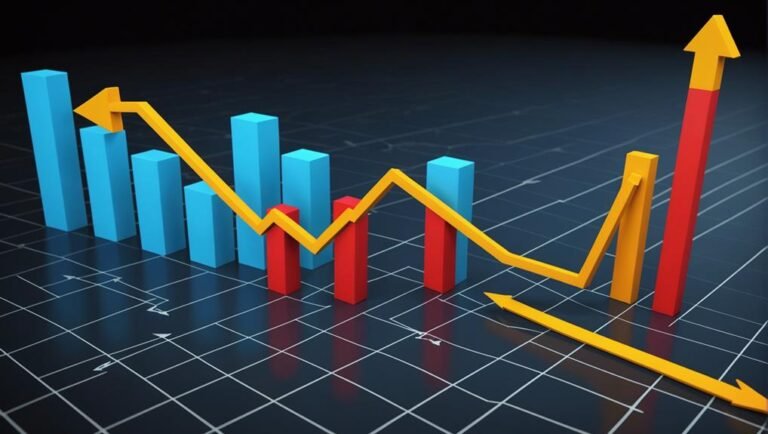Equilibrium Price: Definition, Types, Example, and How to Calculate
Understanding equilibrium price is essential as it represents the point where market supply and demand intersect, ensuring pricing stability. Types of equilibrium provide insight into market dynamics, economic stability, and competition. Examples include the housing and stock markets, showcasing balance between supply and demand. Calculating equilibrium price involves various formulas and graphical analysis to determine the market clearing price. Factors like consumer preferences, input costs, and technological advancements influence this price. This concept is fundamental for comprehending market efficiency and real-world economic applications.
Key Takeaways
- Equilibrium price is the intersection of market supply and demand.
- Types of equilibrium offer insights into economic stability and dynamics.
- Equilibrium ensures balance, stability, and efficient pricing in markets.
- Examples include housing market equilibrium and equilibrium in the stock market.
- Calculation involves various formula methods and graphical analysis for market clearing prices.
Definition of Equilibrium Price
The concept of equilibrium price serves as a pivotal point in economics, denoting the precise intersection where market supply harmonizes with demand, ensuring a state of balance and stability in pricing dynamics. Calculation methods for determining this price involve analyzing market dynamics, where forces of supply and demand interact to establish a point where quantity supplied equals quantity demanded.
Equilibrium price is essential for understanding market efficiency and ensuring that goods and services are allocated efficiently. In a competitive market, prices fluctuate around this equilibrium point as market conditions change. Maintaining awareness of equilibrium price helps businesses make informed decisions regarding production levels and pricing strategies to adapt to changing market conditions effectively.
Types of Equilibrium in Economics
Analyzing various types of equilibrium in economics yields valuable insights into market dynamics and the interplay between supply and demand forces.
- Market Dynamics: Understanding different types of equilibrium provides a deeper insight into how markets function and adapt to changing conditions.
- Economic Stability: Examining equilibrium types helps in evaluating the level of stability in an economy and how quickly it can return to balance after disturbances.
- Critical Equilibrium: Competition among sellers and buyers plays a significant role in achieving a balanced state in markets.
- General Equilibrium: Considering macro-economic forces rather than individual markets gives a broader perspective on economic stability and performance.
Examples of Equilibrium in Markets
In market scenarios, equilibrium manifests as the pivotal point where supply aligns seamlessly with demand. Market stability hinges on achieving a delicate balance between supply and demand dynamics. When supply equals demand, price fluctuations are minimized, fostering a stable market environment.
For instance, in the housing market, equilibrium is struck when the number of houses for sale matches the number of potential buyers. This equilibrium leads to stable prices, preventing drastic fluctuations. Similarly, in the stock market, equilibrium occurs when the number of shares investors want to buy matches the number available for sale.
Understanding and maintaining supply balance are essential for sustaining equilibrium and ensuring a harmonious marketplace.
Calculation of Equilibrium Price
Frequently overlooked in economic analyses, the calculation of equilibrium price plays a pivotal role in understanding market dynamics and pricing mechanisms. When determining the equilibrium price, different formula variations can be utilized, depending on the specific market conditions and variables involved.
Here are some common methods for calculating the equilibrium price:
- Basic Equilibrium Price Formula: This formula compares the quantity demanded and the quantity supplied to find the point of equilibrium.
- Inverse Demand and Supply Functions: Using these functions, equilibrium price can be calculated by setting supply equal to demand.
- Market Clearing Price Calculation: This method focuses on finding the price at which the quantity supplied equals the quantity demanded.
- Graphical Analysis: Graphs can visually represent the intersection of supply and demand curves to determine the equilibrium price.
Factors Influencing Equilibrium Price
Moving from the calculation of equilibrium price to examining the factors influencing equilibrium price reveals the intricate interplay of market dynamics shaping pricing outcomes.
Factors influencing equilibrium price include changes in consumer preferences, input costs, technology advancements, and government regulations. Consumer preferences drive demand shifts, affecting the equilibrium price by influencing how much buyers are willing to pay for a product.
Input costs, such as raw materials and labor, impact supply levels, thereby influencing the equilibrium price point. Technological advancements can increase efficiency, leading to changes in production costs and ultimately affecting equilibrium price.
Government regulations, like taxes or subsidies, can directly impact production costs or consumer purchasing power, causing shifts in equilibrium price by altering supply and demand levels. Understanding these factors is essential for predicting and adapting to price fluctuations in dynamic markets.
Importance of Equilibrium in Economics
The foundational concept of equilibrium in economics underscores the essential stability and balance required for efficient market functioning. This equilibrium plays a pivotal role in shaping economic outcomes and market dynamics. Understanding the importance of equilibrium in economics is essential for both policymakers and market participants.
Below are four key reasons highlighting the significance of equilibrium:
- Market Stability: Equilibrium guarantees that markets remain stable by balancing supply and demand.
- Economic Balance: It signifies a state of economic balance where market forces are in harmony.
- Efficient Resource Allocation: Equilibrium facilitates the best allocation of resources, enhancing productivity.
- Price Stability: Maintaining equilibrium helps in achieving stable prices, benefiting both consumers and producers.
Real-World Applications of Equilibrium Price
Achieving peak market efficiency and predictability relies heavily on the real-world applications of equilibrium price theory. In the supply chain, equilibrium price guarantees that the quantity of goods supplied matches consumer demand, preventing overstocking or shortages. This balance is essential for optimizing production levels, reducing waste, and enhancing overall supply chain performance.
In the labor market, equilibrium price plays an important role in determining fair wages for workers based on the equilibrium between labor supply and demand. When wages align with equilibrium price, it fosters a stable job market, minimizes unemployment, and promotes economic growth.
Understanding and applying equilibrium price concepts in real-world scenarios like the supply chain and labor market are necessary necessary for fostering sustainable economic development and market stability.
Conclusion
To sum up, equilibrium price plays a vital role in maintaining market stability by balancing supply and demand dynamics. Understanding the various types of equilibrium in economics and how to calculate equilibrium price is essential for comprehending market interactions.
An interesting statistic to note is that according to the law of demand, as the price of a good increases, the quantity demanded decreases, highlighting the intricate relationship between price and demand in determining equilibrium.







